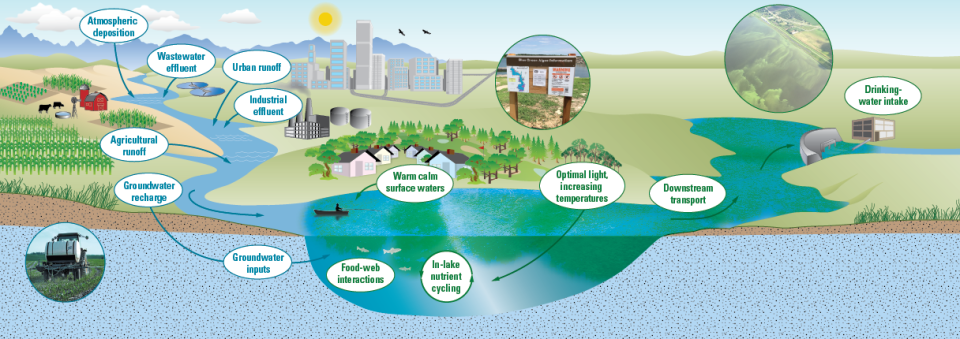What Causes HABs
Causes of Harmful Algal Blooms
Both physical and chemical factors contribute to the formation and persistence of HABs in freshwater and marine systems, including:
- nutrient loading (both nitrogen and phosphorus, including organic forms);
- light availability;
- water temperature;
- alteration of water flow;
- salinity
- stratification/vertical mixing;
- pH changes; and
- trace metals.
Because of the interplay of these factors, there may be large temporal fluctuations in the levels of harmful algae and toxin production. Not all algal blooms produce toxins and there may be a mismatch between peaks in biomass and toxin production. Scientists are learning that factors including the ratio of nitrogen to phosphorus, organic nutrient supply, temperature, and light attenuation, play important and interacting roles in determining HAB composition and toxin production. The precise drivers of toxin production are still an active area of research.

How Human Activities Increase the Occurrence of Harmful Algal Blooms
There is general agreement within the scientific community that the incidence of HABs is increasing both in the U.S. and worldwide. This recent increase in the magnitude, extent and frequency of HABs has been attributed to increasing anthropogenic activities and their interaction with factors known to contribute to the growth of blooms. Point source pollution (which may include discharges from municipal and industrial wastewater treatment plants, concentrated animal feeding operations, Municipal Separate Storm Sewer Systems, stormwater associated with industrial activity, and non-point source pollution which may include diffuse runoff from agricultural fields, residential lands, roads and stormwater) may be high in nitrogen and phosphorus and can promote or cause excessive fertilization (eutrophication) of both flowing and non-flowing waters.
In addition, warmer temperatures for longer periods of time caused by climate change favor HAB taxa and may be improving their competitive fitness over other non-harmful algal taxa. Other effects of climate change that exacerbate HABs include stronger vertical temperature stratification, sea level rise and salinity, changes in coastal upwelling, increases in carbon dioxide, and increased runoff caused by more intense rainfall.
